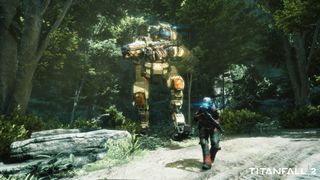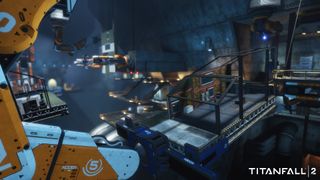Titanfall 2’s singleplayer campaign is more Portal 2 than Call of Duty
We spent two hours with the surprising FPS that dedicates as much energy to gleeful experimentation as mowing down bad guys.
Glad you asked. I spent an entire day playing it and came away very impressed. For more details, check out the full multiplayer preview, accompanied by nearly 30 minutes of PC gameplay footage.
Call of Duty, but with big robots—if you'd asked me to guess what Titanfall 2's campaign would look like before I played it, that would've been my gut reaction. It's partially correct. The basic act of shooting feels as twitchy and instantaneous as any Call of Duty, and there are giant robot exoskeletons to pilot, but Titanfall 2 isn't nearly that simple.
You shoot bad guys, sure, but you also have branching conversations with a robot companion and Super-Meat-Boy your way through challenging platforming gauntlets, all set in a cohesive, mysterious science fiction world. It’s one of the most surprising action shooters I’ve played in recent memory, a planetary tour that gets more mileage out of experimenting with level design and traversal than no-scoping enemy infantry.
Titanfall 2 puts you in the role of Jack Cooper (a very exotic and rare name in the future), a rifleman in the Frontier Militia, a group set on expanding human settlements into rimworld colonies. They need an armed force because the Interstellar Manufacturing Corporation—a Weyland-Yutani-esque example of capitalism’s worst case scenario—openly believes human lives are expendable and planets are only good for their profit potential, even though they’re humans too. And they practice what they preach, tearing up defenseless Frontier settlements in the name of planetary fracking. It’s a caricature of modern environmental and economic issues, but if the characters are written well enough, the contrived backdrop may not matter. Either way: robots.

My demo started off in a short training scenario, a VR simulation in which Cooper’s CO gives him the expected rundown on pilot controls. There’s even a timed test with leaderboard integration, a fun throwback to Modern Warfare’s training course. But right before Titan training, you’re jostled out of the simulation. Your ship is under attack and just after hopping in an escape pod, it crashes down to the mountainous jungles of the planet Typhon below. Shortly after landing, you and your CO get into a scuffle with IMC soldiers, leaving your boss friend mortally wounded. With his final words, he bonds his titan, who goes by BT, to you. Equipped with a learning CPU, BT is no ordinary titan: it’s a self-aware entity and a fully realized character that you can climb inside of. Think Watson, the talking IBM supercomputer, but with guns and a godawful sense of humor.
Clear the gunway
Before BT can get moving, I needed a few batteries, which are conveniently scattered within a reasonable distance from the crash site. This part of the campaign is no secret—Respawn has already shown the pilot wallrun along Typhon's cliffsides and leap hundreds of feet across a crevasse directly into a firefight. It looks cool enough, but playing it is another thing. While the platforming paths are pretty strict—there’s really only one way to move through the environment—failure isn’t severely punished. If I fell to my death, which wasn’t often (so far), I respawned instantly at the last solid ground I jumped from.
Firefights are playgrounds for player expression, tense set pieces that make use of every tool available to the pilot.
Firefights are playgrounds for player expression, tense set pieces that make use of every tool available to the pilot. Of those tools, the most important is the ability to cloak yourself. It works on a cooldown and only lasts a few seconds, but proves invaluable right away. Since firefights often take place in wide open arenas with multiple tiers of walkways or rock formations, it’s really easy to back yourself into a corner, so the cloak functions as a get out of jail free card. Use it to reposition yourself and flank the bulk of the enemy forces. If stealth is your strong suit, you can treat combat arenas like Far Cry outposts, sneaking around, bouncing from cover to cover with the cloak and knocking out the enemies one by one—until things inevitably go wrong.

When they do, Titanfall 2 leans into its parkour and level design. Enemies have a tougher time hitting you while you’re wall-running and levels are set up to encourage such acrobatics. One level takes place in an underground manufacturing plant, and to escape you need to follow the massive assembly line, hopping between moving platforms as they rotate and spill out into the abyss below. It’s as easy to get crushed by a robotic arm or compression plate as it is to get shot by the IMC forces filling out the platforms and workspaces adjacent to the assembly line. I could hop down from the assembly line and thin out the IMC forces at any point, or I could stealth and platform my way through without harming a fly. It’s a radical design choice for a shooter that comes from some of the same minds behind Call of Duty 4.
Attack on titans
It didn’t become clear what the underground assembly line was putting together until the very end, when a couch suddenly dropped down on the platform I planned my getaway on (and yes, it can kill you). Robotic arms started manufacturing a rudimentary house around me, slamming down walls and furniture, and then rotating it 90 degrees until the living room wall became the floor. I had to clamber up the inside of a house flipped on its side and into a huge dome on the surface where an entire town assembled itself out of the assembly line below.
PC Gamer Newsletter
Sign up to get the best content of the week, and great gaming deals, as picked by the editors.

After a shootout in the impromptu village, I escaped through a hole in the wall of the arena and met back up with BT. From there, I could hop in and out of BT at will, taking on infantry and titan enemies in the same ways multiplayer allows. Titan shootouts are a fun way to mix up the quick, reactionary pilot shooter play with slower battles that hinge more on positioning, sightlines, and reading the opponent. They have bulky, distinct silhouettes that clearly telegraph their actions: shields degrade from bright blue to red, signifying an opportunity to attack, and the more powerful projectiles move slow enough to allow for a dodge or shield up in response. As you progress, more titan loadouts become available, which you can switch out at any point. They mirror the six loadouts available in the multiplayer titans, so if Scorch’s AoE flame attacks aren’t working against a team of Northstar fliers, switch to Tone’s armaments and knock them out of the sky.
Respawn also focuses the slow intensity of titan combat with one-on-one boss battles. I fought an enemy Ronin—the sword-wielding titan—piloted by an enemy NPC that had been antagonizing me throughout most of the assembly line level. We’ll be getting closer to the big villains beyond the occasional cutscene, and they’re pretty challenging—I died a few times. After switching to a Northstar loadout, I charged my ultimate attack and rained down justice—I mean, missiles from above, safely out of reach from that massive sword.
We might be in for the most creative shooter campaign this year.
The final stage of the demo jumped me ahead a few levels in the campaign to a full-on titan assault on an IMC base, a massive battlefield where six or so friendly titans charged the enemy lines, an equal force of enemy titans. It was absolute chaos. My health was constantly low—you can only recharge by walking over the batteries of destroyed titans—and prioritizing targets was a hectic challenge. It felt like a genuine science-fiction war zone that legitimized the scale of the conflict between the Frontier and IMC forces.
To go from an intricate underground Aperture Science-esque platforming gauntlet to piloting a massive robot on a screaming battlefield within the same two hours illustrates the surprising breadth of Titanfall 2’s campaign. I expected Titanfall 2 to be a whack-a-mole shooter tour through a few linear levels—a silly blockbuster robot fantasy. If what I played is any indication, we might be in for the most creative shooter campaign this year. The inverse of Doom, an FPS that went for intense, focused gunplay, Titanfall 2 is aiming for variety, to be an amusement park of playful shooter and platforming experiments.
We’ll know for sure when Titanfall 2 releases on October 28th.
James is stuck in an endless loop, playing the Dark Souls games on repeat until Elden Ring and Silksong set him free. He's a truffle pig for indie horror and weird FPS games too, seeking out games that actively hurt to play. Otherwise he's wandering Austin, identifying mushrooms and doodling grackles.
Most Popular





